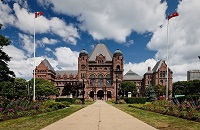

by Maurice Y. Michaud (he/him)
 Canada’s legislative assemblies vary considerably in size from one jurisdiction to another. Although one should make a distinction between eligible voters and overall population, the table below nonetheless provides some perspective on these variations by listing each jurisdiction with its estimated population in 2025 and the average number of people represented by each member. However, it is important to remember how that average number conceals how some jurisdictions may have:
Canada’s legislative assemblies vary considerably in size from one jurisdiction to another. Although one should make a distinction between eligible voters and overall population, the table below nonetheless provides some perspective on these variations by listing each jurisdiction with its estimated population in 2025 and the average number of people represented by each member. However, it is important to remember how that average number conceals how some jurisdictions may have:
Related topics
→ A brief history of ridings in the Canadian jurisdictions
→ Considerations when redrawing an electoral map
→ Number of ridings and seats over time in the Canadian jurisdictions
Also, the population in some ridings might be noticeably higher than the average if it includes many young families, but the number of persons 18 years or over who are eligible to vote in those ridings could be in line with the jurisdiction’s average. In fact, to account for such variance, Saskatchewan is one province that, during its decennial redistributions, calculates its new electoral quotient only on the number of persons who are 18 years of age or older, whereas Elections Canada seems to consider total population.
| Legend } | p/s: Average population/seat %s: Percentage of seats |
|||||||||||
| Jurisdiction | Federal | Prov/Terr | General Elections | |||||||||
|---|---|---|---|---|---|---|---|---|---|---|---|---|
| Details | Capital city | Largest city | Population | Seats | p/s | %s | Seats | p/s | ← | → | ||
| 1 | CA |  |
Ottawa | Toronto | 41,548,787 † 41,414,862 |
343 340 |
121,133 121,808 |
n/a | — | — | 2025-04-28 | 2029-10-15* |
| 8 | BC |  |
Victoria | Vancouver | 5,719,961 13.81% |
43 | 133,022 | 12.65% | 93 | 61,505 | 2024-10-19 | 2028-10-21 |
| 9 | AB |  |
Edmonton | Calgary | 4,980,659 12.03% |
37 | 134,612 | 10.88% | 87 | 57,249 | 2023-05-29 | 2027-10-18 |
| 10 | SK |  |
Regina | Saskatoon | 1,253,569 3.03% |
14 | 89,541 | 4.12% | 61 | 20,550 | 2024-10-28 | 2028-10-30 |
| 11 | MB |  |
Winnipeg | Winnipeg | 1,507,330 3.64% |
14 | 107,666 | 4.12% | 57 | 26,444 | 2023-10-03 | 2027-10-05 |
| 6 | ON |  |
Toronto | Toronto | 16,176,977 39.06% |
122 | 132,598 | 35.88% | 124 | 130,459 | 2025-02-27 | 2029-06-07 |
| 5 | QC |  |
Québec | Montréal | 9,110,616 22.00% |
78 | 116,803 | 22.94% | 125 | 72,885 | 2022-10-03 | 2026-10-05 |
| 3 | NB |  |
Fredericton | Moncton | 859,839 2.08% |
10 | 85,984 | 2.94% | 49 | 17,548 | 2024-10-21 | 2028-10-23 |
| 2 | NS |  |
Halifax | Halifax | 1,080,418 2.61% |
11 | 98,220 | 3.24% | 55 | 19,644 | 2024-11-26 | 2028-07-19 |
| 4 | PE |  |
Charlottetown | Charlottetown | 180,029 0.43% |
4 | 45,007 | 1.18% | 27 | 6,668 | 2023-04-03 | 2027-10-04 |
| 7 | NL |  |
St. John’s | St. John’s | 545,464 1.32% |
7 | 77,923 | 2.06% | 40 | 13,637 | 2025-10-14 | 2029-10-15 |
| 12 | YT |  |
Whitehorse | Whitehorse | 47,111 0.11% |
1 | n/a | n/a | 21 | 2,243 | 2021-04-12 | 2025-11-03 |
| 14 | NT |  |
Yellowknife | Yellowknife | 45,242 0.11% |
1 | n/a | n/a | 19 | 2,381 | 2023-11-14 | 2027-10-05 |
| 13 | NU |  |
Iqaluit | Iqaluit | 41,572 0.10% |
1 | n/a | n/a | 22 | 1,890 | 2021-10-25 | 2025-10-27 |
| † Excluding the territories. The average population/seat is calculated with the population of the provinces only. Note: At the provincial or territorial levels, except for the three Maritime provinces, a number of far-northern seats are in fact excluded from the jurisdiction’s calculation of the average population/seat, but the calculations presented in this table do not exclude them. As a result, the official figure used by each jurisdiction is higher. * The current context could lead to a general election being held sooner. |
||||||||||||